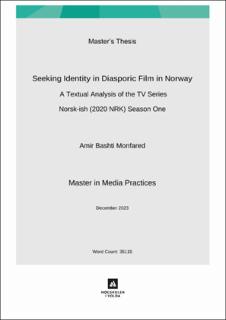Seeking Identity in Diasporic Film in Norway. A Textual Analysis of the TV Series Norsk-ish (2020 NRK) Season One
Master thesis
Permanent lenke
https://hdl.handle.net/11250/3117994Utgivelsesdato
2023Metadata
Vis full innførselSamlinger
Sammendrag
The first and second-generation migrants in Norway now have more opportunities to tell their stories of diasporic experiences in the entertainment industry due to the recent film and television industry's inclusive policies. Fresh perspectives and voices diversify the industry’s cultural landscape, and the filmmakers' bottom-up approach may lessen the stigmatizing portrayals of minorities in the media.
In addition to exploring contemporary literature on migrant and diasporic film, both globally and in Norway, this thesis investigates the discourses raised in the fictional series "Norsk-ish" (in English: Norwegian-ish) Season One, which aired on the Norwegian Public Broadcasting Network (NRK) in 2020. The series was co-written and created by two Norwegian artists, Bahareh Badavi and Melike Leblebijioglu, the second generation of migrants in Norway. Semi-structured interviews with them have benefited the exploration of thematic and contextual elements of this research.
Using the textual analysis approach within the realm of cultural studies, I have examined how socio-cultural elements in the TV series relate to challenges experienced by migrant communities. In this study, emphasis is placed more on analyzing these cultural aspects rather than film elements. To understand how communities are portrayed and notions of minority and majority identities are depicted through characters' struggles, I closely examine representations of three diasporas: Iranian, Turkish, and Punjabi Indian.
As second-generation migrants, Norsk-ish's main characters struggle with traditional values from their parents' homelands and certain cultural aspects of Norwegian society. The diasporic home, however, appears to be significantly more troublesome for them than Norwegian society. The intensification of this approach has sometimes perpetuated previously seen stereotypes of first-generation migrants in the Norwegian media. I argue that due to the series' overemphasis on sympathy for second-generation characters' struggles, the represented diasporas are inadvertently depicted as less sympathetic. Norsk-ish writers disagreed with my argument regarding the negative representation of a particular migrant community, leading to a constructive analytical debate in this study. The series' main strengths include its skillful depiction of characters caught between two cultures and value systems, the diaspora and Norway. Furthermore, it suggests an alternative collective space for second-generation individuals. I propose Norsk-ish as an artistically worthwhile work whose narrative elements significantly contribute to its thematic depth and the portrayal of its discourses' complexities.
